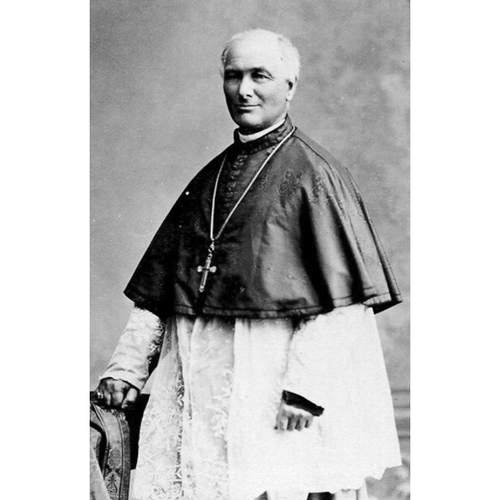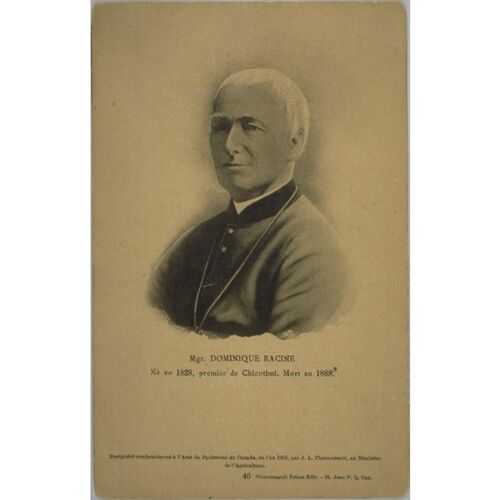RACINE, DOMINIQUE, Roman Catholic priest and bishop; b. 21 Jan. 1828 in the parish of Saint-Ambroise, Jeune-Lorette (Loretteville), Lower Canada, son of Michel Racine, a blacksmith, and Louise Pepin; d. 28 Jan. 1888 at Chicoutimi, Que.
Dominique Racine’s father died at about the age of 40, leaving one daughter and six sons, the eldest of whom was 15. The family was brought up in very modest circumstances, verging on real poverty. From early childhood Dominique, the second youngest, was no doubt influenced by his brothers Michel and Antoine*, both of whom studied at the Séminaire de Québec. He himself studied there from 1840 to 1849, and then attended the Grand Séminaire until 1853 when he was ordained priest. The remainder of his life was extremely active. Until 1858 he was curate in the parish of Notre-Dame in Quebec, and a secretary in the office of the archdiocese. In 1859 he ministered to the parish of Saint-Basile. He was parish priest of Saint-Patrice at Rivière-du-Loup from 1859 to 1862, and first came into contact with the Saguenay region in 1862 when he was appointed vicar forane and parish priest of Chicoutimi.
Abbé Racine travelled all over this immense region with its rigorous climate for many years, building, preaching, and working unremittingly to organize the church in the Saguenay, and never failing to display the profound graciousness to which his contemporaries often testified. His efforts were crowned by the erection of the diocese of Chicoutimi (embracing the counties of Chicoutimi and Saguenay, Charlevoix, and Lac Saint-Jean), of which he became the first bishop on 4 Aug. 1878. Meanwhile he had established in the region both the first convent school, which in 1864 was entrusted to the Congregation of the Sisters, Servants of the Immaculate Heart of Mary, known as the Sisters of the Good Shepherd, and in 1873 a seminary which produced several generations of priests. Finally, in 1882 he founded the Hôtel-Dieu de Saint-Vallier at Chicoutimi, run by the Religieuses Hospitalières de la Miséricorde de Jésus (Augustinian Nuns), and a domestic training college at Roberval, for which the Ursulines of Quebec assumed responsibility. He was also active in public life, participating in the dispute over the railway from Quebec City to the Saguenay in which regional interests and those of Quebec financiers clashed, the controversies arising from the stagnant state of agriculture, and the latent conflict resulting from the iniquitous conditions imposed on lumbermen by the family of William Price*.
From 1871, as vicar general to Bishop Elzéar-Alexandre Taschereau*, Racine spoke out on current issues such as the controversy between the Université Laval and its Montreal branch [see Ignace Bourget; Joseph Desautels], the division of the diocese of Trois-Rivières [see Luc Desilets], and the Jesuit estates question [see Antoine-Nicolas Braun]. In 1882 and 1885, in Rome, he served as the forceful spokesman for the archbishop of Quebec on the university question. His correspondence reveals his continuing attention to the affairs of Quebec as well as those of his diocese.
Racine thus made an important contribution to the creation and maintenance of the social power of the clergy in the Saguenay. This power was clearly demonstrated when the Hotel-Dieu de Saint-Vallier was founded. In January 1882 Bishop Racine had learned that the federal government had authorized the construction of a naval hospital in Chicoutimi. He wanted the hospital to be run by nuns, but the contract stipulated that a layman must manage it. Bishop Racine was opposed to a lay hospital and, as a friend of Sir Hector-Louis Langevin*, the minister of public works, he managed to overcome the opposition and to have the Religieuses Hospitalières de la Miséricorde de Jésus put in charge of the new institution. In so doing he was, however, able to win over all parties, and to form friendships among both the powerful and the humble. Proof of this came in the unusual activity following his death and the extraordinary manifestations of piety it called forth. The news of his death, which occurred in mid-winter, brought people of all ages and conditions from the diocese and beyond to Chicoutimi. Around his coffin, people fought for shreds of his clothing and stubs of candles; relics were made of his hair and his cassock; his heart was bequeathed to the seminary, his lungs to the nuns of the Hôtel-Dieu. One could cite many other facts attesting to the affection which this man had been able to command.
Reflecting on the socio-economic context and the cultural environment in which Bishop Racine lived, one can imagine the power he wielded. He was, it would seem, rightly credited with not abusing that power, and with managing his affairs with much wisdom. The spiritual orientation he sought to give his clergy, the simplicity and moderation he adopted in his public life, and the efforts he made to calm discord in the Saguenay, all substantiate this claim.
ANQ-Q, État civil, Catholiques, Saint-Ambroise (Loretteville), 21 janv. 1828. ANQ-SLSJ, Coll. Victor Tremblay, Doc., 168–69. Arch. de l’évêché de Chicoutimi (Chicoutimi, Qué.), Reg. des lettres, I. Mandements, lettres pastorales et circulaires des évêques de Chicoutimi, Monseigneur Dominique Racine, volume unique, 1878–1888 (Chicoutimi, 1903). Le Canadien, 30 janv. 1888. Le Progrès du Saguenay (Chicoutimi), 2 févr. 1888. Allaire, Dictionnaire. J.-C. Drolet, Monseigneur Dominique Racine, bâtisseur de l’Église saguenéenne ([Chicoutimi], 1968). F.-X.-E. Frenette, Notices biographiques et notes historiques sur le diocèse de Chicoutimi (Chicoutimi, 1945). Histoire de l’Hôtel-Dieu Saint-Vallier de Chicoutimi, 1884–1934 (Chicoutimi, 1934). J.-H. Charland, “Mgr Dominique Racine, 1re évêque de Chicoutimi,” Rev. canadienne, 3e sér., 1 (1888): 724–28. Raymond Vézina, “Théophile Hamel, premier peintre du Saguenay,” Saguenayensia (Chicoutimi), 17 (1975 ): 10–16.
Cite This Article
Gérard Bouchard, “RACINE, DOMINIQUE,” in Dictionary of Canadian Biography, vol. 11, University of Toronto/Université Laval, 2003–, accessed April 12, 2025, https://www.biographi.ca/en/bio/racine_dominique_11E.html.
The citation above shows the format for footnotes and endnotes according to the Chicago manual of style (16th edition). Information to be used in other citation formats:
| Permalink: | https://www.biographi.ca/en/bio/racine_dominique_11E.html |
| Author of Article: | Gérard Bouchard |
| Title of Article: | RACINE, DOMINIQUE |
| Publication Name: | Dictionary of Canadian Biography, vol. 11 |
| Publisher: | University of Toronto/Université Laval |
| Year of revision: | 1982 |
| Access Date: | April 12, 2025 |


![Mgr. Dominique Racine [image fixe] Original title: Mgr. Dominique Racine [image fixe]](/bioimages/w600.4993.jpg)


